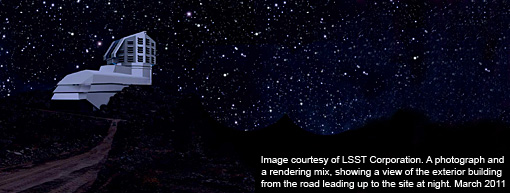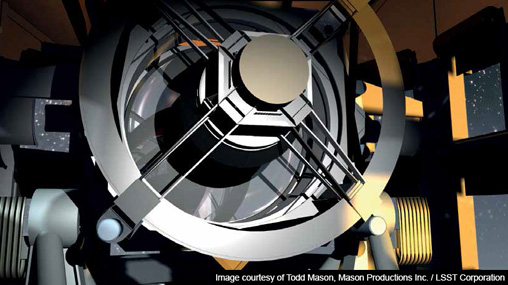Graham P Smith on the challenge of redefining 'big' in a dark universe.
Humankind faces an intriguing and exciting truth at the beginning of the 21st century. Data from our most powerful and innovative telescopes is consistent with the overwhelming majority of the matter and energy in our Universe being invisible – the so-called dark matter and dark energy. Indeed, the only direct evidence for these fundamental constituents of the Universe comes from astronomical observations. The evidence comes literally from pointing ever more powerful telescopes at the night sky, and peering deeper and deeper into outer space.

Early evidence for dark matter came from Fritz Zwicky’s observations of the Coma Galaxy Cluster – the most massive object in the known Universe at that time – with the biggest telescope on the planetin the 1930s. Today, observational cosmologists, including myself, study dark matter in galaxy clusters, as they strive to constrain the properties of the dark matter particle.
While cosmologists’ best estimates are that dark matter accounts for one fifth of the total mass-energy content of the Universe, dark energy represents almost three quarters of the mass-energy. This leaves just one 20th of the Universe in the form of ordinary matter with which we are familiar! The strange sounding concept of mass-energy relies on arguably the most famous equation in history, Einstein’s deceptively simple E=mc2. To add up the entire content of the Universe, we must include all of the mass and all of the energy.
Dark energy is a term that refers tothe new physics required to interpret many aspects of modern astronomical observations, including that distant Type Ia supernovae (a particular type of exploding star) are dimmer and thus further away than expected, and that galaxy clusters are growing more slowly than expected. We have known since Edwin Hubble’s observations in the 1920s that the Universe is expanding. Modern observations of supernovae, galaxy clusters, and other classes of astronomical object all indicate that the cosmic expansion has been gradually speeding up. Bizarre as it sounds, the Universe started a growth spurt in mid-life, caused by a phenomenon akin to a repulsive gravity. Figuring out the laws of physics responsible for this cosmic growth spurt is a huge interdisciplinary challenge!
The quest to measure and understand dark energy is a source of great excitement in the global astronomy and cosmology community. For example, I lead international teams that are developing methods to find, count, and weigh galaxy clusters back to when the Universe was just a few billion years old. We are giant hunters on the grandest scale imaginable! Galaxy clusters are the most massive objects in the Universe, true cosmic giants, weighing roughly one million billion times the mass of the Sun. In the next two decades we aim to find roughly 100,000 of these giants and weigh every one of them. We’re aiming to measure the effect that the Universe’s growth spurt has had on the rate at which cosmic giants put on weight. This will give us crucial information on the mysterious dark energy that causes this cosmic growth spurt.
To achieve our goals requires a big telescope, namely the Large Synoptic Survey Telescope (LSST). With its diameter of 8.4 metres LSST’s primary mirror is equivalent to the combined height of almost five adults. LSST will observe a big patch of sky every time it stares into the cosmos – equivalent to the size of 50 full moons in one shot! This US-led survey telescope will revolutionise astronomy following its planned first view of the night sky in 2022. Arguably the most amazing fact about LSST is that in the first month of its lifetime it will survey more sky than all humans have surveyed so far, with all telescopes in history!

No wonder then, that LSST is widely regarded as the missing piece in the UK’s ground-based astronomy programme. It’s quite simple: given the US funding model, LSST needs the UK. Given the scientific potential, the UK needs LSST. We have a fantastic opportunity to join LSST, with the entire UK astronomy community backing our bid. This support stems from the simple fact that LSST will have a profound impact right across UK astronomy. Here in Birmingham our work in cosmology and galaxy clusters, as well as our studies of advanced statistical techniques to mine large data sets will greatly benefit from UK involvement in LSST. This revolutionary telescope will also provide us with an ideal complement to our effort in gravitational-wave observations to unravel the mysteries of some of the most extreme objects in the Universe.
LSST also has profound importance for UK innovation and economic success. LSST will deliver an astronomical dataset of unprecedented size, with a requirement to store, transfer, process, and deliver data on a scale never seen before. This is a ‘big data’ challenge, on the scale championed by the Department for Business Innovation and Skills as of key strategic importance for the UK economy. Investing in the computer technology, infrastructure, and algorithms required for our science goals can only help to drive innovation and train young people for future careers. Indeed, LSST engagement with young people will start in schools, benefiting from repeated LSST observations of the night sky over a ten-year period, to make a movie of the ever-changing sky. Showing the dynamic evolving Universe in which we live to young people in the UK will help to stimulate interest in studying scientific subjects at school and university.
Dr Graham P Smith is Director of the University of Birmingham Observatory